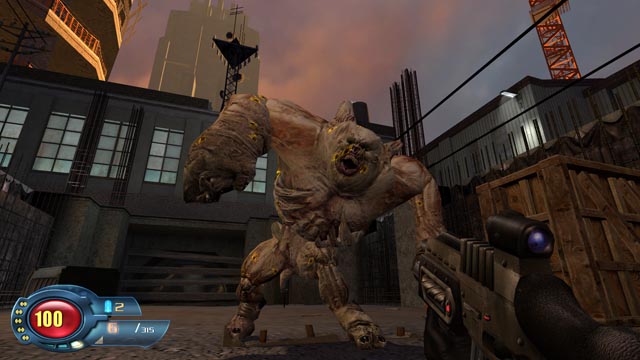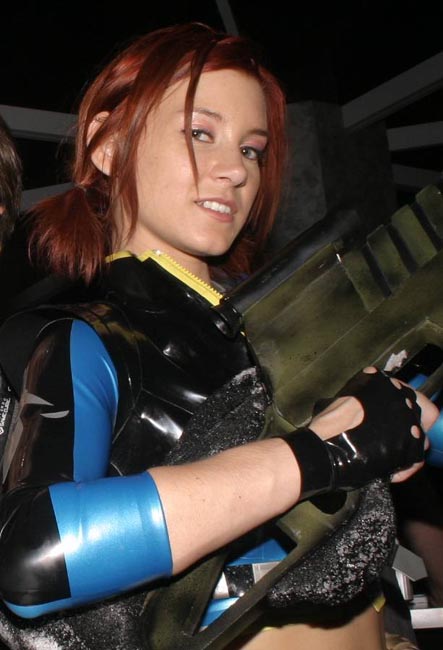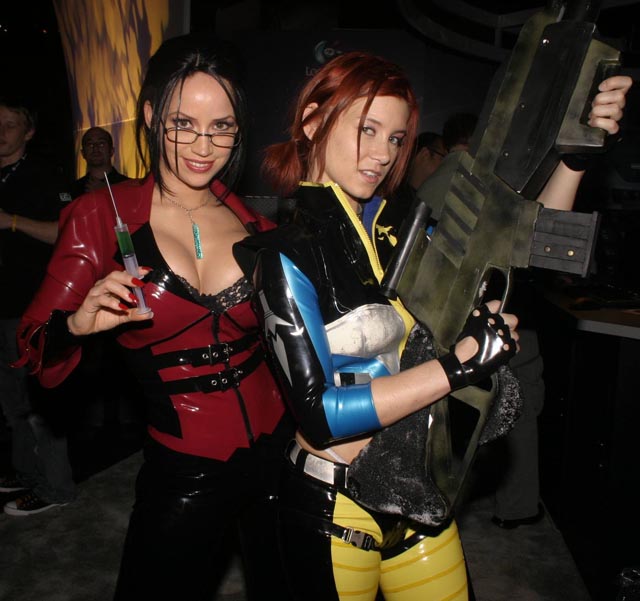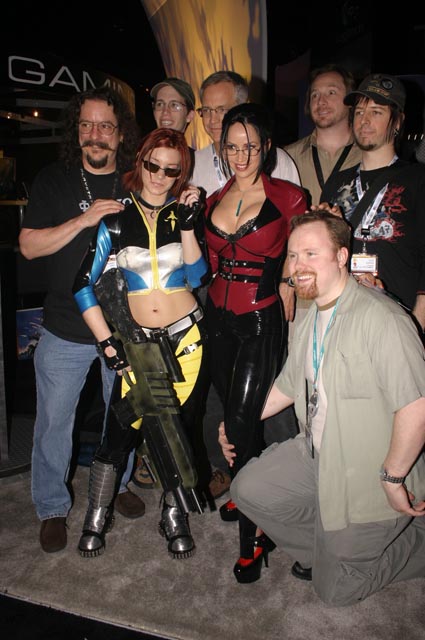Ahoy, squirts! Quint here with the newest AICN Games column. Monki has started unpeeling his interviews from E3 and starts us with Tom Mustaine, VP of Development at Ritual... they chat about this PC game SiN, which might be jumping to a console soon... all details are below. Before I hand you over to Monki, I'd just like to thank everybody for writing in with your support. I know my partner in crime, Merrick, has responded to many of you and we're hoping to have a solid core to keep you folks up to date on the video game world. If you have any scoops, suggestions, comments or cheat codes, feel free to email us at games@aintitcool.com. Now I turn the tables over to our primate before he starts throwing his turds at me. Enjoy!!!
Like Merrick, I’m without a tagline yet. So, Monki here with a fun interview I did with Tom Mustaine, the VP of Development on SiN Episodes: Emergence. SiN is getting a lot of interest right now due in part to the episodic nature of the game. Each game is being released at $19.99 with new releases coming every few months or so. After talking to Tom I’ve really hope this type of release works because it sounds like it will bring a lot of new techniques of creating games in the future.
Lots of people are really excited about this game and I am just now starting to get into the game itself. The ARG aspect of it is also something that is very cool and very innovative. So, read on about how Tom and the Ritual team are creating a kickass game for a kickass price.

Tom: This is the best game ever made.
Monki: *Laughs*
Tom: I’m just saying…do you know anything else about it besides the hi-level [of graphics].
Monki: Not really.
Tom: Do you play Half-Life 2?
Monki: I’ve played it for a little bit.
Tom: Okay, your a shooters fan or no?
Monki: Yeah, love the first persons.
Tom: So, Half-Life 2 engine in it, based on the Half-Life 2 engine. We’re the first real AAA episodic game. The real important part of that for us is we want to be at the same visual and quality bar as games like Half-Life 2 at the non-episodic model, but at the $20 price point...our set $20 price point. Ourselves and Valve are two of the first ones that are kind of innovating this space. We’re the first ones, Valve’s is coming out about a month later and we’re going to have a catalog of Valve episodes and Ritual episodes over the next year. And we’re just going to get more and more.
We have 9 episodes currently planned for this game. They are completely stand-alone episodes so, each one is part of a bigger meta story-arc, but you can play each one independently and it has its own heroes, journeys, story arc and what not, so you can jump in anywhere in the middle and play what you want. Actually this episode starts with the whole intention of us, we have a prequel episode and that’s from earlier on, so you start without really any deep information about what’s going on here, it’s just kind of ‘oh crap, what’s happening’ and you kind of run with the ball. So, there’s some pretty cool stuff here. We’re taking a lot of cues from shows like Lost and 24 and other serialized episodic content in TV and in movies. Our goal is to get the games out once every six to eight months and to get stuff to gamers more frequently. And at Ritual and Valve we take things very seriously to do episodic even more so than just every six to eight months. We treat those as kind of milestone markers and in the middle we have our arena release, the mode they are playing, they’re competing for one of these computers over there. [A group of gamers were huddled around some kiosks] It’s an arena mode which uses our dynamic difficulty system where they can play against the computer and it tunes up and down. The winner gets that machine, but we’re going to release that mode in about a month so more content, about three or four months from now they’re gunna get multi-player, so more content, and then of course, the next episode. So anyone who buys an episode is going to get content, content, content. It’s not just ‘here you go, here you go.’ It’s continual updates to a live codebase. Do you play Counterstrike at all or any of those kinds of games?
Monki: A little bit, not very much.
Tom: The Counterstrike source is a really good example. Although they don’t call it episodic because it’s kind of too small to really be in that space. They release Counterstrike source with one map, and then they release a new map about every other couple months. And it’s really truly a bit of an episodic sense. They don’t charge for it, but for us, it makes us focus much better on features. That we pick a set of features that are much more condensed and much more compact, we don’t have to go ‘this is a one-off title we gotta put it on the shelves, it better sell well, so that means we gotta cram every god-damn feature under the sun into it,’ well we don’t have to do that. We can pick features, dole them out in our episodes, pick really really risky, hi-risk features and say ‘we’re gunna try this, and if it doesn’t work in this episode, we’re going to stick to our guns and do these other features,’ but like in this one, we spent some time on our, we spent significant time over the years trying to develop a system that we call our dynamic difficulty, our personal challenge system. What it does is it tracks an enormous number of stats in single-player in real time and the intention is we grab those stats and we tune the game according to your skill level. So you pick kind of a challenge, and how often do you want the game to adjust or help you and what happens is the game will tune automatically. The game tunes up and down based on your skill level, so you start the game, when you do a new game, you can choose are you a casual gamer, are you an extreme gamer. So if you are a hardcore gamer you go way over here, how often the game will assist you, so it’s a very fluid, not just easy-medium-hard, which is usually a very set way of playing. You can pick one of these skill levels and as long as you stay alive the game is still going to tune to you.

It’s a system that’s really never been done before, at least at the level that we’re doing it and it allows us to do some really cool stuff. Cause, what we’re doing is tracking against all of these things: pacing, exploration, health, how much damage you’ve done, how the A.I. adjusts to aide, how much threat it needs to give you, how much intel, the type that gets spawned. So, like if you are a really good FPS player and you get headshots all the time, your strategy is to shoot in the head because guys die immediately, well we start putting helmets on their heads, after a while we start putting body armor on their body. If you’re ducking around corners a lot they start throwing grenades, they start working together as a team. It tunes up pretty significantly so the hardcore gamer still has a real challenge on their game and it’s pretty funny, we’ve actually gotten some complaints on forums these guys like, ‘it’s really hard,’ it’s like, ‘well, you’re a good gamer right?’ ‘yeah’ ‘are you having fun?’ ‘yeah’ well there ya go. So then they’re like ‘yeah, your right holy crap it got harder for me, that’s good.’ Conversely, for gamers who are not so good at these games, this is really a big part of this for us was that we were building this so that we could get more consumers in who haven’t played shooters before. Shooters are still a very hardcore gamer kind of game, and what we’ve done with this is the difficulty will tune down so the guys will still shoot around you, but they’ll miss you a lot, they’ll hit you an do less damage, so it’s still the same intensity, if not more, but you’re still having a good time and not dying so frequently. So, what we did is we had a play test in Dallas where we had a hardcore CPL guy like Fatal1ty, one of those CPL competitors, with an RTS gamer who had never played a shooter before. They both started at exactly the same time and finished within 15 minutes of each other. Never been done before in a game. So it’s a really open-ended system that is really the next step in A.I. and the next step in the way games need to grab on to more consumers. This is one of our biggest things. For community its going to be pretty cool, they’ve be able to save their stats, upload their stats, when they upload their stats, this is a big part of our episodic element too, we’re able to take those stats and see what they did in the game and make adjustments to further episodes so, kind of like the Death of Robin thing with DC comics, the community got to choose whether Robin lived or died. Here, we can check stats, and if people keep killing certain characters or letting them die, we’re just going to get rid of them. Right, so the community makes decisions.
Monki: That’s cool.
Tom: Plus we pay very close attention to the community. They’re much closer to us, we’re much closer to them. And we get some big changes to the game based on their feedback. It’s pretty cool stuff. As far as SiN is concerned, do you know anything about the SiN story or any of that good stuff?
Monki: Not really.
Tom: SiN Episodes is a sequel essentially to SiN 1 which came out in 1998. In the SiN universe it’s based in a city called Freeport City, which is kind of a mixture of San Francisco, Tokyo and New York kind of crammed into one on a waterfront. What’s happened in our little future, it’s not so far in the future that it pulls you out of the reality; it’s still very grounded. There are some games, which I won’t mention, that are so far out there that their guns are like ‘what the hell am I looking it.’ It really pulls people out of their fiction. So, we’re a little bit in the future, and what happened is the government stopped providing police, there are no more police in the world, they’re all handled by private organizations, private firms. So of course you’ve got good firms and bad firms. You’ve got Elexis Sinclaire who’s our primary bad girl. She’s the meta-story arc bad girl. She was the bad girl from the first one.

That’s that girl right there, [points to booth-babe] she’s over there of course. She’s kind of the big bad girl, she runs a company called SiNTEK which is where the name of the game came from, SiN. That’s her right there. So you’ve got the bad girl for the whole series of the game and then the bad guy for this particular episode. But, she runs SiNTEK and you, the hero, John Blade run a company called HardCorps and you’re kind of the good guys, she’s the bad guy. She also has a ton of money, she’s like huge, biggest corporation in the world, she’s into biochemicals, she wants to mutate people in the world, she wants to change things her own way. So it’s a big kind of a big comic book kind of conflict you see with traditional kind of comic book kind of larger-than-life characters. This is Jessica she’s one of the good guys as well. We know our target audience pretty well too.

Monki: *Laughs* No kidding.
Tom: One of the big things about SiN, this is kind of the intro, we start the game off you have no idea what’s happening, and you just kind of run with it. I mentioned that a little earlier. One of the other big features in SiN 1, one of the things that really differentiated us back in the day and still to this day is still something that games aren’t doing a lot in the shooter space, we really get upset when we see a tester play the game, they run up to a phone booth and hit use, and nothing happens. It happens all the time. And then they never use anything ever again so that key is worthless. We try to make sure everything in the game that looks useable or destroyable is. Its one of our big key staples is interactivity from the first game. So give me a second to get to this sequence, I’m in the ambush scenario here. We have phones in the game that you can dial numbers on and get crazy messages. There’s all this graffiti in the world, posters you can dial numbers and what not. We have consoles you can interact with. Everything you can pick up using the Half-Life physics system to throw, twist. So we did made a lot of modifications to that to make it a little more elaborate.
All of our weapons are pretty interesting. We only have three weapons in this episode but what we can do is we have a primary fire, you can zoom down the scope, we have a secondary fire, this one is a penetrative shot, I can’t actually really show it off very well in this space, of course it will penetrate, it will shoot holes in the wall and it has an antigen component to kill mutants. Which you have mutants in this world. You can also throw off-handed grenades and melee guys up close. You have kind of a toolbox. With every gun you have a big toolbox. So we have our shotgun, which is pretty standard, but you can zoom down the scope take guys out up close and also bounce shots around corners. We have our assault rifle you can shoot guys like this [primary fire], zoom down the scope; also blast guys up close. So our guns, thanks to our dynamic difficulty system we a lot of people use them like a toolbox; very open-ended kind of sandbox. Cause the A.I. will do interesting things to adapt to your behavior and then people will start using their guns differently so if you’re starting to shoot guys in the head they’ll put helmets on. What people start doing instead of shooting the guys in the head with the helmets is they go up and they start meleeing them or throwing grenades at them, so we see very, very cool kind of immersion behavior out of how the players play the game. And it’s all really thanks to how our dynamic difficulty system adjusts in real time. In our play testing we had a pretty elaborate system where we could track exactly what every player does and then pull it back into our level editor. To see how many times they were using certain things, what they were looking at, where they got stuck. We use that play testing, we had over 100 people come in and play test the game, and we made a lot of serious adjustments to the game for the gamer, not for ourselves. We had a lot of stuff that we thought was cool, people would play and be like, ‘I don’t like that,’ so we’d take it out. Our target audience is people who want to play these games and enjoy them and we’ll modify the game accordingly. This is what Valve does with their games as well, and its something that really makes a difference in the fun-factor of the games.

From the story-arc perspective, we wanted to put a lot of stuff in the game that people didn’t see on the surface level. But if they dig into it they’ll find a ton of new information about the game, and part of the lore and story arc that is part of our pulling from things like Lost. Lost has so much cool stuff going on that is really under the hood. The average watcher, ‘hey whatever,’ but the fucking hardcore, they’re going to dig into it and be like, ‘oh god, I called the resistance and I called blah-blah-blah,’ we have a ton of that stuff in the game. We also have a context look system so, if I look at something long enough that is actually of interest. There’s a lot of things in the games that where you look at it, I can look at something and it will put a little icon up so you can solicit from your teammates you can say, ‘I want to know more about this,’ and she’ll say something more about it. It requires you to kind of explore in an adventurer capacity and get more information about the game world. So people will be looking around, spending more time. Our levels aren’t just set pieces, they are interactive living places and they have more information under the hood.
We have guys, constantly, everyone, everyone, I don’t know what it is about spinning objects, every single person that play tested would shoot this thing. [A spinning ceiling fan] So this one we never intended to be destroyable but of course after enough times we wanted to make sure it exploded really well for them. Almost nobody shot those, [pointing to some hanging lights] so we didn’t make them destroyable.
This level is actually inside an oil tanker that is listing sideways, and a drug-lord has built a drug lab inside it, right-side up; so its kind of a hidden place. We have a lot of really fantastic environments in our big city. So here’s some of that back-story stuff down here. You can dig in to some stuff that happened in our first game. Information here, there’s a lot of information in the game about the story. [He punches some numbers into a phone and gets a message within the game] I can’t understand it of course, but you can hear what’s going on here.
Monki: So have you guys ever thought about doing an ARG aspect to the game? Would that be the next big step?
Tom: We did a significant ARG at the beginning of the game. We did a website called legionpharma.com which for months had nothing to do with the game at all and had enormous amounts of puzzles and hidden stuff in it. It was kind of a shoestring ARG, I’m actually writing an article about it, cause compared to something like I Love Bees, it was, you know, I love bees was a multi-million dollar endeavor from Microsoft, for us it was like we built this ARG, it had the names in there from the first SiN game and people found it and were like, ‘what is this, what is this?’ and started digging into it and got into our puzzles. We had about, I think, fourteen puzzles and the last three never got solved. So we’re going to give more information to the gamers out there how to solve those puzzles and we’re going to reintroduce between episodes more ARG stuff. So yeah, there’s a whole subculture in this game called ARCH-13. You watch Lost?
Monki: Yeah, I love Lost.
Tom: ARCH-13 is our Dharma. You know what I mean? Exactly that. I’ll show you something, how far are you on Lost?
Monki: I’m caught up.
Tom: I’ll show you something you’ll love about the last video. You’ll find it amusing. This is a little thing we did for E3 to get people to come to the booth to play our challenge. It’s real short, I’ll keep talking about the game stuff, just ignore this for a second; I’ll show you the stuff that matters. You have any other questions?
Monki: Is this going to be PC only I’m guessing?
Tom: We’re actually…no. We’re gunna do a 360 version at some point in the future. We haven’t finalized those plans yet so I haven’t really announced it yet. But we will be doing it. We also are hoping to be doing a Playstation 3 version as well. We were looking at Marketplace for the 360 because episodic on Marketplace would make a lot of sense. Here ya go, you might like this. So, in order to enter in to the challenge they have to put their name and badge number in, so this little video. We had a couple people on some Lost forums actually catch this that were SiN fans and Lost fans. [The lost numbers are entered in on the video]
Monki: 4 8 15 yeah, nice.
Tom: *laughs* So its funny, the number, then it dials back and it actually plays, so its just a tiny little thing, but it shows how rabid lost fans are you know. It’s phenomenal. We’re throwing and they’re catching.

Very cool stuff. This has been, from a game development perspective, we have developed this game completely on our own. We self-funded this game, and actually being able to do that and to be able to be in control of the content and being able to choose what we want to have in the game and to choose how the episodes roll out has made a really phenomenal difference in how much fun its been to develop for developers. I don’t know how tight you are with game developers in general or how much you know about the industry and what not.
Monki: Well, I’m in the industry to an extent, I do marketing and stuff.
Tom: Okay yeah, so it can be a real grind at times. But in this model, it doesn’t get old. Because you spend six to eight months on a title, it’s not like spending three or four years. You’re going to spend over time, a number of times you get to innovate. Over and over and over again. And that’s a really good feeling. For us we get to take, this is a point where technology and hardware and software have finally come together for us. I feel like that’s why episodic is really right around the corner, Valve is taking that risk as well. A number of other developers have announced episodic this year too. But with broadband penetration being so high in the U.S. and obviously abroad, its much higher in other countries, broadband mixed with technology like Valve’s engine, the Source engine, which they continually update, so we don’t have to worry about this getting too old, mixed with this basically the knowledge and the desire to have things like the XBox Marketplace, things like Steam where it’s a community where people are willing to give their credit card. You got those three things coming together, software, hardware and technology. It really may get time for episodic to make sense.
Monki: Grand Theft Auto, they just announced the next one would be episodic or is going to have episodic stuff on it. I mean that’s one thing that I was really curious about. I mean, where did this idea come? At what point did someone say ‘hey, we should release nine hour episodes.’?
Tom: People have been talking about this for a long time but its really, you have a problem with price point and taking huge amounts of risk cause typically, the real issue with episodic for us, okay, we spent a year on this one. About six months of that was building the episode the rest was building foundational assets. So it takes about that long to build a good foundation for a really AAA game. So publishers and developers alike can’t take those risks, ya know, say ‘build a AAA game in six months’ that just doesn’t happen. So with Half-Life they have a huge base to draw from. Like we built all our game models, our character models, we built some weapons. We’re going to enhance that, like what World of Warcraft did. Right. They build this huge world and now they add and add and add. It’s the same kind of a challenge; it really just kind of makes more sense in general. And its something we’ve been trying to do for years. But now with all of those conversions it kind of makes sense to actually do it. There was a point in time where shareware was kind of that space, like the old Doom days.
Monki: Oh yeah, ’94.
Tom: But what they were doing was just splitting the game up into chunks what we’re doing is self-contained stand-alone episodes.
Monki: So this one is available now?
Tom: Yeah it came out on Wednesday. [May 10th]

So, a very big thanks go to Tom, pictured on the bottom right there, holding on the leg of the booth-babe in red. You can check out more about SiN at http://www.ritual.com/. So, I’m new to this whole transcribing game, Quint has been doing it for ages now, but man, it’s tougher than I thought!
Anyway, I’ve got a bunch more interviews recorded that I will be putting up over the upcoming weeks to keep you guys informed on everything that is cool video games! Until then, back up to the tops of these Texas trees (where the sky is less smoggy) I go!
-Monki
Send your favorite quotes from The Wizard to monki@aintitcoolmail.com
